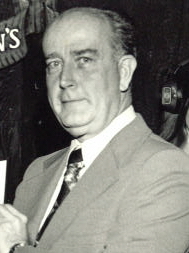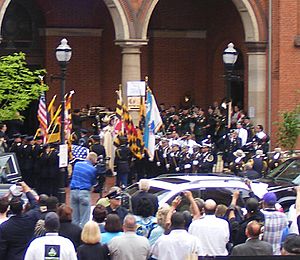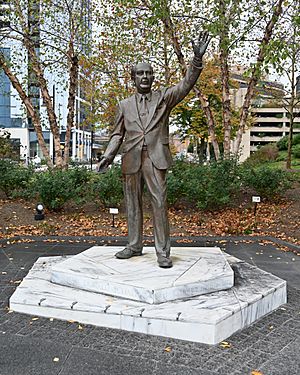William Donald Schaefer facts for kids
Quick facts for kids
William Donald Schaefer
|
|
|---|---|
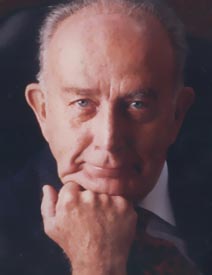 |
|
| 58th Governor of Maryland | |
| In office January 21, 1987 – January 18, 1995 |
|
| Lieutenant | Melvin Steinberg |
| Preceded by | Harry Hughes |
| Succeeded by | Parris Glendening |
| 32nd Comptroller of Maryland | |
| In office January 25, 1999 – January 22, 2007 |
|
| Governor | Parris Glendening Bob Ehrlich Martin O'Malley |
| Preceded by | Robert L. Swann |
| Succeeded by | Peter Franchot |
| 45th Mayor of Baltimore | |
| In office December 1971 – January 26, 1987 |
|
| Preceded by | Thomas D'Alesandro |
| Succeeded by | Clarence H. Burns |
| Personal details | |
| Born | November 2, 1921 Baltimore, Maryland, U.S. |
| Died | April 18, 2011 (aged 89) Catonsville, Maryland, U.S. |
| Political party | Democratic |
| Alma mater | Baltimore City College (high school) University of Baltimore |
| Military service | |
| Allegiance | |
| Branch/service | United States Army Reserves (1946–1979) |
| Years of service | 1942–1979 |
| Rank | Colonel |
| Battles/wars | World War II |
William Donald Schaefer (November 2, 1921 – April 18, 2011) was an American politician. He worked in public service for 50 years in Maryland.
Schaefer was a member of the Democratic Party. He served as the 45th Mayor of Baltimore from 1971 to 1987. He was also the 58th Governor of Maryland from 1987 to 1995. Later, he became the 32nd Comptroller of Maryland from 1999 to 2007.
Contents
Early Life and Career
Schaefer was born in Baltimore, Maryland, on November 2, 1921. He was the only child of Tululu and William Schaefer. He grew up in West Baltimore.
He went to public schools in Baltimore. He graduated from Baltimore City College high school in 1939. Schaefer later earned law degrees from the University of Baltimore School of Law.
During World War II, Schaefer joined the United States Army. He helped manage hospitals in England and Western Europe. He stayed in the U.S. Army Reserves until 1979. He retired with the rank of colonel.
After his military service, Schaefer became a lawyer. He lived with his mother in Baltimore for most of his life.
Schaefer first ran for public office in 1950. He lost two elections for the Maryland House of Delegates. In 1955, he won a seat on the Baltimore City Council. He focused on city planning and housing. In 1967, he became president of the City Council. In 1971, he was elected Mayor of Baltimore.
Mayor of Baltimore (1971–1987)
Schaefer served four terms as mayor. He was first elected in 1971 and won re-election three times. He often received more than 85% of the votes. He was known for paying close attention to details. He would note things like trash on the streets and order them to be fixed.
A famous photo shows him in a bathing suit with a rubber duck. He was at the National Aquarium in Baltimore during its construction. This was to settle a bet that it would open on time in 1981. This event gained national attention.
In 1984, Schaefer appointed Bishop L. Robinson. He became Baltimore's first African-American police commissioner.
During his time as mayor, many large factories were closing. Schaefer knew this would hurt Baltimore's economy. He decided to focus on tourism to help the city. He supported building the new Baltimore Convention Center in 1979. He also pushed for the development of "Harborplace" at the Inner Harbor. This area became a popular marketplace with shops and restaurants.
These projects helped transform Baltimore. The city became a major tourist destination. Esquire magazine named Schaefer "the best mayor in America" in 1984.
The Colts Leave Baltimore
The Baltimore Colts football team played at Memorial Stadium. The team owner, Robert Irsay, felt the stadium was old. He wanted a new stadium with better seats and parking.
Mayor Schaefer tried to keep the team in Baltimore. He had an agreement with Irsay that he would be called before any move. However, after some legal actions in Maryland, Irsay moved the team. In March 1984, the Colts moved to Indianapolis. Schaefer was very disappointed by this.
Ravens Arrive in Baltimore
The Colts were not the first team to leave Baltimore. In 1973, the Baltimore Bullets basketball team moved to Landover, Maryland. They became the Capital Bullets.
Years later, Baltimore would get a new football team. The Cleveland Browns moved to Baltimore in 1996. They were renamed the Baltimore Ravens.
Governor of Maryland (1987–1995)
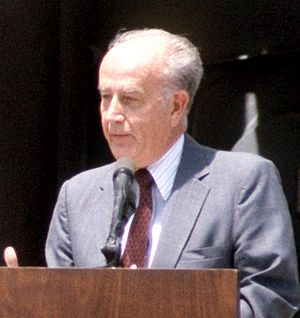
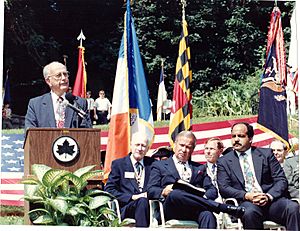
In 1986, Schaefer was elected the 58th Governor of Maryland. He won with a very large percentage of the votes. He was re-elected in 1990.
As governor, Schaefer worked to reduce unemployment. He helped save 600 jobs at a major company in Western Maryland.
His time as governor led to important projects. These included building Oriole Park at Camden Yards. He also worked on cleaning up the Chesapeake Bay. He helped improve standards for public schools.
Schaefer also supported the Baltimore Light Rail system. This electric train line runs for 30 miles. It connects areas from Hunt Valley to Glen Burnie. The first part of the light rail opened in 1992.
In 1992, Governor Schaefer supported Republican President George H. W. Bush. This was unusual because Schaefer was a Democrat. Schaefer served two four-year terms as governor. He left office on January 18, 1995.
After Being Governor
After being governor, Schaefer worked for a law firm. He also held a special teaching position at the University of Maryland, College Park.
Schaefer had a close friend named Hilda Mae Snoops. She was his "official hostess" at the Governor's mansion. She helped design a rose garden and a fountain there. After her death, the fountain became a topic of discussion.
Comptroller of Maryland (1999–2007)
In 1998, Schaefer ran for Comptroller of Maryland. This position manages the state's finances. He won the election by a large margin. He took office on January 25, 1999. In 2002, he was re-elected with almost 68% of the vote.
Schaefer sometimes had disagreements with Governor Parris Glendening. However, he had a much better relationship with Governor Bob Ehrlich.
2006 Re-election Campaign
In 2006, Schaefer ran for re-election as Comptroller. He faced two challengers in the Democratic primary election. During the campaign, some of his comments about an opponent's appearance caused controversy. Some people wondered if his age was affecting him.
On September 12, 2006, Schaefer lost the primary election. This was his first election loss since 1954. He finished in third place.
Schaefer's last day as Comptroller was January 19, 2007. He then moved to a retirement community. His health declined in his final years.
Death
William Donald Schaefer died on April 18, 2011, at age 89. He had been hospitalized for pneumonia. His funeral was held at Old St. Paul's Episcopal Church in Baltimore. He was buried at Dulaney Valley Memorial Gardens.
Legacy
In 1978, Schaefer received an award for his public service. This was the U.S. Senator John Heinz Award.
Schaefer created the "Civic Fund" as mayor. This fund gave small grants to neighborhoods for projects. After his death, more money was added to this fund. It continues to support community projects today.
In 2009, a statue of Schaefer was put up in Baltimore's Inner Harbor.
Several buildings are named in his honor:
- The William Donald Schaefer Building in downtown Baltimore.
- The William Donald Schaefer Engineering Building at Morgan State University.
- William Donald Schaefer Hall at St. Mary's College of Maryland.
- The Governor William Donald Schaefer International Terminal (Concourse E) at Baltimore-Washington International Thurgood Marshall Airport (BWI).
- The William Donald Schaefer Auditorium at Baltimore City College, his old high school.


